The US’ Tilt Towards India: Overview And Projections – Analysis
By IPCS
By Md Farijuddin Khan*
The US policy towards India has hardly been predictable. At the moment, the US’ India policy is guided purely by its commercial and strategic regional interests. However, the New Delhi-Washington bilateral has transformed from a fissured partnership to that of a solid bilateral relationship based on mutual understanding and common interests.
This has been possible because of India’s sharper strategic focus on the US under the incumbent Indian Prime Minister Narendra Modi-led government.
US Policy Re-alignment
In January 2014, India and the US were locked in a bitter diplomatic row. A year on, incumbent US President Barack Obama was the chief guest of India’s 65th Republic Day parade. The warm ties cultivated by the incumbent heads of governments of both countries, thanks to initiatives taken by the Indian prime minister over the past few months cannot be underestimated. This is a clear message that the foundations of India-US relationship are strong and resilient.
The shift in Washington’s policy in New Delhi’s favour had much to do with its dire need to shift focus on other regions – the Asia-Pacific and West Asia. The US views India as a regional net security provider for at least two basic reasons: first, it considers India as a responsible emerging power committed to established international laws and norms. It also views India’s democracy and political set-up as a model for the subcontinent in addition to being a regional economic powerhouse. Second, Washington seems to consider New Delhi as a potential ally for positive engagement with Beijing with a mandate to keep the sea lines of communications (SLOC) in the Indian Ocean free and safe for international trade and navigation.
This line of reasoning was illustrated in the January 2015 signing of the U.S.-India Joint Strategic Vision for the Asia-Pacific and Indian Ocean Region. This document mentions safeguarding regional maritime security, which is a vital US national security interest in the Asia-Pacific.
Perspective from India
India’s has reciprocated to this gesture of the US with a combination of enthusiasm and principled reluctance. India has maintained that it would focus on bilateral relations, thereby getting maximum advantage out of the partnership. India’s approach to such gestures shows that it both recognises the importance placed on it as a major player in maintaining peace and security in the world, and also sidelines any push to behave as a traditional US military ally – particularly on openly posturing against China in any dispute. India’s foreign policy principle has been guided by non-interference, non-alignment and non-aggression. In the post-Cold War Asian era, becoming a ‘linchpin’ of an entity is not a bad strategy provided that the objective and terms of becoming a ‘linchpin’ suits India’s economic, political and strategic interests and considerations.
Yet, Modi’s US policy carries a sharper strategic focus. With rising security threats posed by both state and non-state actors, India under the Modi-led government needs strong strategic partnership with the US to bolster its military capabilities. Border disputes with two neighbors – China and Pakistan – combined with asymmetric security threats posed by jihadist terrorism, the expansion of al Qaeda and the Islamic State (IS) in the subcontinent, among others, feed much of New Delhi’s logic to push for a stronger strategic partnership with the superpower. The recent India-US defence deal worth $2.5 billion is a case in point.
India signed a defence deal with the US based on her security needs. The New Delhi-Washington defence relations are guided by India’s national interests. India might benefit more than the US if the robustness of this partnership is maintained in the future years.
We are currently in an era of the strongest India-US bilateral ties. Nevertheless, the US’s constant pushing of India to abandon its policy of maintaining ‘strategic autonomy’ and asking to actively take a concrete stand in disputes involving US interests in Asia should be avoided. India should be cautious enough to avoid such downsides while partnering with US.
Looking Ahead
In 2016, the US policy vis-à-vis South Asia will remain dominated by its regional security interests. Simultaneously, the US-India relationship is also guided by mutual understanding towards reaping economic benefits of the two-way trade between the two large economies.
In the post-withdrawal period in Kabul, a more intense New Delhi-Washington cooperation than before will be required to preserve and secure the shared long-term commitment to help build a secure, stable, and democratic Afghanistan.
The US will likely treat India and Pakistan based on their individual merits – a stand endorsed by the incumbent US secretary of state. This means Pakistan’s significance in the US’ policy formulation in the region will remain intact, at least, under the current administration.
However, Obama appears to have clearly conveyed to Pakistani Prime Minister Nawaz Sharif – during the latter’s visit to Washington – that the US would not be able to strike a deal similar to the one with New Delhi in 2005, with Islamabad.
Regardless of assumes the presidential office the 2016 US elections, India-US relations will remain stable with greater hope to sort out the existing major constraints in the bilateral, such as nuclear liability, intellectual property rights, and so on.
* Md Farijuddin Khan
Doctoral Candidate and Senior Research Fellow, U.S. Studies Programme, Jawaharlal Nehru University
E-mail: [email protected]

